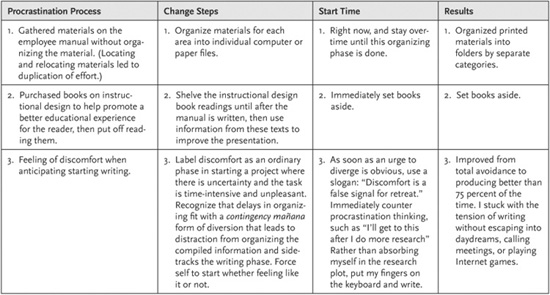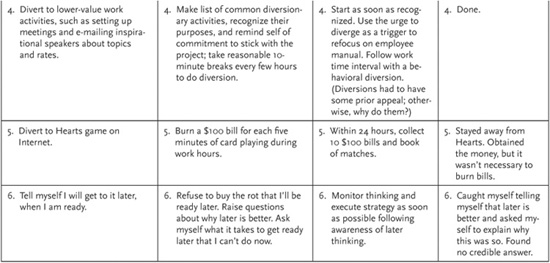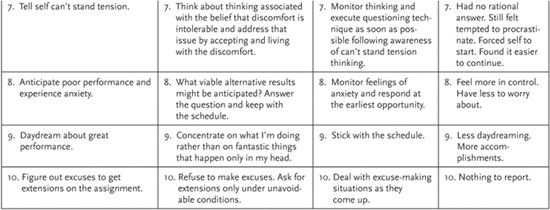End Procrastination Now! (20 page)
Read End Procrastination Now! Online
Authors: William D. Knaus

Create a three-file system (you can create an e-filing system as well). Label the first file “catch-up.” Label the second “keep-up.” Label the third “get-ahead.”
The catch-up file includes previously procrastinated activities that remain timely and important to do. Throw away whatever will not come back to haunt you. The keep-up file contains current activities, such as those that you might have on your cross-off list. The get-ahead file includes activities that, if you were to get a jump on them, could advance your interests and make your life easier later.
Spend time every day with your catch-up file and whittle it down until it's empty. Emphasize the keep-up file to prevent its contents from flowing into the catch-up file. Make time every day for your get-ahead file. This is where you work toward achieving what you envision.
We all have short-term tasks that get put off, such as canceling a dental appointment. If you need to cancel an appointment, do it when you think of it. This gets your mind onto something that is more productive to do. It also eliminates nagging self-reminders and making excuses for the last-minute cancellation.
A slight positive change in throwing off daily details can make a significant long-term difference. You can prevent small matters from becoming a crisis because they have been delayed too long. If you can't do something when you think of it, write it in a pocket notebook or record it. Then refer to the recording when you are free to respond. Then, do it the first time that you can.
So far, you've looked at what you can do to go it alone as you organize and regulate your actions. Nevertheless, when you are confronting a complex procrastination habit, you may need all the help you can get. Who are the people in your life that you can call upon if the going gets tough? When you enlist help on specific procrastination issues, you may find that you have little need to call on them because you know that you can. However, a weekly check-in is a good rule-of-thumb approach to keep your buddy connected to and interested in your counter-procrastination efforts.
Get your act together and get rolling! Make a plan for how you will gear up for the change, and start the change in motion. Pick a start date. Publicly announce your intentions. Make a deal with a buddy to monitor your change program periodically. Start at the appointed date and time. Expect and accept making adjustments to your plan. Chart your progress. Routinely remind yourself about
the long-term benefits you will gain and the long-term hassles you will avoid. Press forward.
Procrastination can have a snowball effect: one diversion can roll over into another. In an earlier chapter, you saw how the ABCDE approach can be used to address complex forms of procrastination successfully. However, another powerful method is through a more comprehensive and structured cognitive-behavioral exercise.
Let's look at Brad's procrastination challenge, which surfaced when he was due to write a comprehensive report. The approach he took was different from his loose and avoiding style when he procrastinated. Doing the structured appealed to him.
In this exercise, Brad mapped his procrastination process, the change steps he would take, when he would start, and what resulted. As the saying goes, a picture is worth a thousand words. The following describes the process and results when Brad successfully came to grips with procrastination by following this plan. But first, let's look at some background information to put this program into context.
Brad had grown into the position of human resources manager for a rapidly growing insurance and financial consulting service company. The company employee handbook had originally been prepared by legal counsel with boilerplate materials. It was outdated and no longer suitable.
The company president wanted a comprehensive manual with graphic artwork, the company logo, a history of the company and its mission, and a state-of-the-art statement of company policies and procedures that conformed to state and federal law. Brad was the manager of human resources. He was the logical person to update the manual. He also had direct access to the company's labor lawyer and was one of the organization's best writers.
Brad had a different take on this. Because of the company's
rapid growth, he was overworked. The task seemed daunting and complex. He found writing the manual laborious, put it off, fell behind, and got two extensions.
Brad was concerned that his procrastination would get him fired. He was baffled. He stated that he was ordinarily well organized, but not for this project. He reported that he had materials piled up around his office. He had materials on policies on sexual harassment, bullying, sick leave, drug testing, health care, education, 401(k) retirement plans, performance reviews, progressive discipline, grievance resolution, and so forth. Downloaded materials were scattered in different sections of his hard drive. Materials and discussion notes from different meetings with legal counsel were scattered among the various papers. In a tone of exasperation, he said, “I got myself in a mess with the paperwork and with my job.”
Brad had a complex form of procrastination. He worried about not living up to the president's expectations. He had high expectations for himself. He badgered himself for messing up his concentration by worrying about what he wasn't doing. He saw the manual as a showpiece for his company and a measure of his worth. However, regardless of the causes for his procrastination, Brad had a new deadline to meet, and this might be his last chance.
We talked about the triggers for Brad's procrastination and fleshed out a number of issues, including his high expectations and behavioral diversions to avoid his failure anxieties. He sheepishly confessed to playing Hearts on the Internet, and that was his biggest diversion. If he was overworked, he acknowledged that this was part of the problem. He lost time by playing the game and saw himself in a perpetual catch-up effort.
Brad caught on quickly about managing his expectations and separating his sense of human value from his employee manualâwriting performance. He felt relieved when he saw that his worth was arbitrarily defined by his performance on the manual. However, he still had the manual to write.
From among the various ways in which he could organize his campaign against procrastinating, Brad decided on a procrastination mapping and correction approach. This approach included
1. Defining the process that he followed when he procrastinated
2. Identifying change steps that he would take
3. Determining a start time for each step
4. Identifying the results from executing each of the steps
Brad took five hours to think things out and to work up the plan. He completed the first three columns, leaving the results column blank. Because he would have to fit the writing into his normal daily routine, he estimated that it would take him 15 days to complete the manual. He then printed 15 copies of his cognitive-behavioral correction plan. He'd complete the results section at the end of each day. This approach helped him stay focused and served as a reminder of what he had already accomplished.
Table 6.1
is the first of the 15 procrastination cognitive-behavioral correction sheets that Brad completed.
Brad stopped playing hearts during his work hours, and changed his procrastination thinking and hair-trigger reaction by introducing several measurable changes into his automatic process. As a by-product of changing the process, he changed the results.
END PROCRASTINATION NOW! TIP
CONTROL
C
oncentrate on shifting from behavioral diversion to purposeful action.
O
rient yourself toward long-term goals and rewards.
N
ip diversionary processes in the bud.
T
ransfer efforts from diversion to priority.
R
eflect to ensure that you are tracking productively.
O
rganize your efforts to pursue your objective.
L
everage your productive efforts to gain advantage.
TABLE 6.1



Table 6.2
is a procrastination cognitive-behavioral correction sheet for you.
Learning takes place in organizations, but formal educational opportunities may be thinning. These reductions don't diminish the importance of keeping up with your craft, profession, or job. Indeed, it is more important today than ever before to take charge of your own learning. However, when procrastination interferes with learning, it is wise to figure out how this happens and take corrective action.
Learning is a complex area. It's how you manage yourself in different learning conditions and when you are facing complexities that shape the outcome. Let's look at a self-regulated learning approach to advance your work when learning is a priority.
Self-regulated learning is an organized approach to learning. You have a learning mission and concrete goals. You think about your thinking (the metacognitive approach). You figure out how to achieve the goal, execute the steps in your plan, evaluate the results, and revise to add to your pool of knowledge. The research on this learning process supports its effectiveness. A self-regulated learning approach is associated with performing at higher levels and efficiently managing multiple complex goals requiring learning and the transfer of new information to achieve these goals. Corrective feedback strengthens this organic learning process.
By putting yourself on a self-regulated path, you take responsibility for how you learn. You pick the goals, the content, the time, and the effort you'll make. You decide the medium for learning, such as distance learning, a manual, a seminar, exploring and experimenting, observing others, and so forth. Self-regulated learning is a proven path to higher levels of accomplishment.
TABLE 6.2